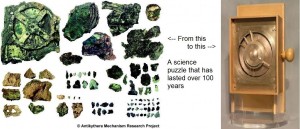Well, January camp is officially over and what a time we had! Much Science was done, friends were made and we all had a great time. Also have to give a huge shout out to our green shirt team who kept camp running smoothly and campers in line and on time! Students need to remember to check into Knowledge Forum at least once a week and post your thoughts on the questions. If you have any questions or have trouble with Knowledge Forum then let me know ouassa@otago.ac.nz.
 On another note I was watching a documentary on the History Channel last night about the world’s oldest computer. This is amazing – a piece of technology that dates back to 1BC that was used to count through lunar and solar years and predict both lunar and solar eclipses. The amount of mechanism, thought and observation that must have gone into this is incredible – and it was done in 1BC!!! The ability of the ancient Greeks to calculate precisely how many teeth to cut into the gear wheels and how to fit them together still amazes me. It makes me wonder , if they could create that with the limited amount of technology they had available to them, what kinds of amazing things will we be able to do in the future?
On another note I was watching a documentary on the History Channel last night about the world’s oldest computer. This is amazing – a piece of technology that dates back to 1BC that was used to count through lunar and solar years and predict both lunar and solar eclipses. The amount of mechanism, thought and observation that must have gone into this is incredible – and it was done in 1BC!!! The ability of the ancient Greeks to calculate precisely how many teeth to cut into the gear wheels and how to fit them together still amazes me. It makes me wonder , if they could create that with the limited amount of technology they had available to them, what kinds of amazing things will we be able to do in the future?
If you want to read more about the actual device, you can go to this website. I also found a youtube movie of an engineer who worked up a model of the device in his spare time using tools and parts that would have been available to the ancient Greeks watch it here.
That is not the end of the story though – the device was found over 100 years ago but although some analysis could be done, scientists were left to guess about what it was actually for. It has only been very recently that we have had the technology to enable an in depth analysis to be carried out. A special X-ray analysis machine was actually built specifically for the purpose of trying to see the device’s internal structure. Techniques for photographing and analysing paintings were used to finally allow detailed observation of writing on the surface of the instrument.
This whole story gives us a wonderful example of the discovery, investigation and observation at the heart of any science. Also, it illustrates the evolution of science as we go from educated guesses 100 years ago of what was almost a black box, to detailed 3d images of the interior of device today. Many scientists worked on the project, making predictions, testing, retesting, and fine tuning their ideas based on evidence. One scientist in the documentary talked about a colossal mistake he had made early on in the project which meant he had to go back and re think and re test his original predictions in light of observation not fitting with his original ideas.
As you head back to school this week and next remember your time at OUASSA and what you have learned but the most important things to remember are to be curious, ask questions, observe and experiment with the world around you. Work hard and don’t be afraid to put yourself out there. Yes, you may not succeed in everything you try but often our best lessons are learned when we look back at our failures.
Look forward to seeing you all on KF soon!






 )
)
Recent Comments